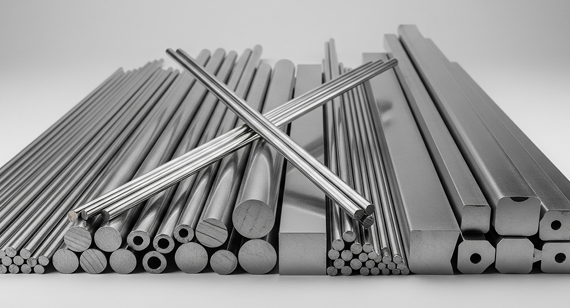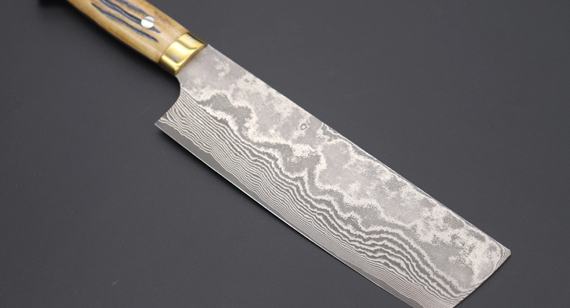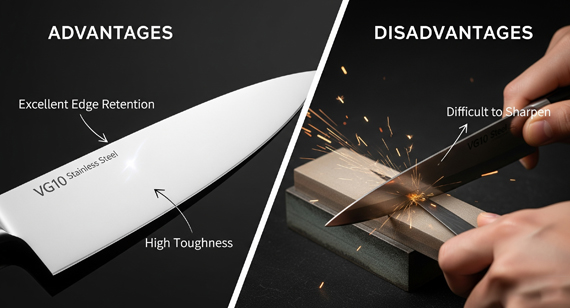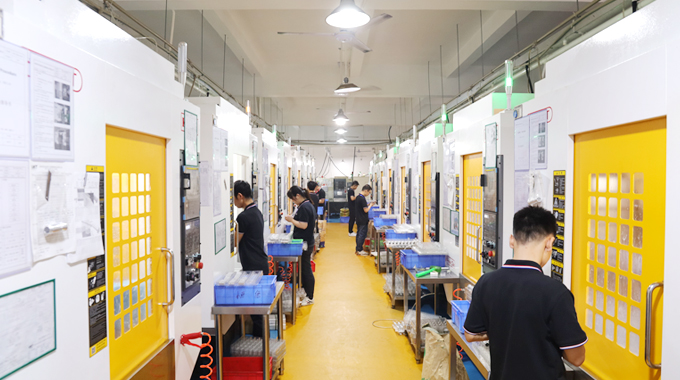15 years one-stop China custom CNC machining parts factory
 115 |
Published by VMT at Sep 12 2025 | Reading Time:About 5 minutes
115 |
Published by VMT at Sep 12 2025 | Reading Time:About 5 minutes
Choosing the right material for knives, tools, or CNC machined parts can be confusing. Many steels offer strength, but not all balance durability, sharpness, and corrosion resistance. This challenge often leads to costly mistakes. VG10 stainless steel solves this by combining hardness, toughness, and resistance—making it a trusted choice in CNC machining and knife-making.
VG10 stainless steel is a high-quality Japanese steel known for its hardness, corrosion resistance, and excellent edge retention. It is widely used in knives, tools, and CNC machined parts, offering a perfect balance of strength and durability. This makes VG10 steel an ideal choice for projects requiring precision and long-lasting performance.
Now that you know why VG10 stainless steel stands out, let’s dive deeper into its definition, properties, and applications to help you decide if it’s right for your project.
VG10 stainless steel is a premium Japanese steel developed by Takefu Special Steel Co., Ltd. The “VG” stands for V Gold, highlighting its “gold standard” quality in cutlery and precision machining. As a high-carbon stainless steel, it contains chromium, molybdenum, cobalt, and vanadium—elements that enhance hardness, wear resistance, and corrosion protection.
This steel is widely used in knives, tools, and CNC machined parts because it balances durability, edge sharpness, and machinability. Its reputation as a versatile VG10 steel grade makes it a preferred material in both the cutlery industry and CNC machining services.

VG10 stainless steel is often compared to other premium knife and tooling steels. In performance, it is close to 440C stainless steel in hardness and corrosion resistance but offers better toughness and edge retention. Compared to ATS-34 or 154CM, VG10 provides similar wear resistance while being easier to sharpen.
In CNC machining, VG10 is considered a mid- to high-end stainless steel grade, offering machinability similar to AUS-10 but with improved strength and durability. This makes it suitable for VG10 steel custom parts where precision and long-term performance are required.
Yes, VG10 stainless steel is highly suitable for knives. It was originally designed for Japanese cutlery and quickly became popular worldwide. Its high carbon content ensures excellent edge retention, while chromium and vanadium provide superior corrosion resistance and toughness. This makes it ideal for chef knives, pocket knives, and outdoor blades.
Knife makers prefer VG10 steel grade because it sharpens easily compared to ultra-hard steels, yet maintains a fine edge for a long time. Users benefit from a blade that resists rust, stays sharp through heavy use, and is easier to maintain.

VG10 stainless steel is a high-carbon, high-performance alloy known for its balance of hardness, toughness, and corrosion resistance. Its composition includes several alloying elements, each designed to enhance cutting performance, machinability, and durability. Below is the typical chemical composition of VG10 steel (MC66 specification):
| Element |
Typical Content (%) |
Function in Alloy |
| Carbon (C) |
0.95 – 1.05 | Increases hardness and edge retention |
| Chromium (Cr) |
14.5 – 15.5 | Provides corrosion resistance and wear resistance |
| Iron (Fe) |
Balance | Base element of the steel |
| Manganese (Mn) |
0.50 | Improves hardness and strength |
| Molybdenum (Mo) |
0.90 – 1.20 | Enhances strength, wear resistance, and toughness |
| Vanadium (V) |
0.20 – 0.30 | Refines grain structure, improves wear resistance |
| Nickel (Ni) |
1.3 – 1.5 | Adds toughness and corrosion resistance |
| Nitrogen (N) |
≤ 0.25 | Improves hardness and pitting corrosion resistance |
| Phosphorus (P) |
≤ 0.03 | Controlled impurity; excessive amounts reduce toughness |
| Silicon (Si) |
0.60 | Enhances strength and improves deoxidization during processing |
| Sulfur (S) |
≤ 0.02 | Controlled impurity; higher content may reduce toughness but improve machinability |
This chemical balance makes VG10 steel grade extremely versatile, especially for VG10 stainless steel knives and CNC machined parts where strength and precision are crucial.
The mechanical properties of VG10 stainless steel define its strength, durability, and performance in both knives and CNC machined parts. These properties make VG10 a balanced steel, offering toughness, wear resistance, and workability for CNC machining services. Below is a summary of its key mechanical properties:
| Property |
Typical Value |
Importance |
| Hardness (HRC) |
59 – 61 | High hardness for edge retention and wear resistance |
| Hardness (HV) |
~ 610 | Indicates material’s resistance to indentation |
| Hardness (HRB) |
~ 105 | Alternative hardness scale for softer comparison |
| Tensile Strength (MPa) |
750 – 950 | Strength before failure under tension |
| Yield Strength (Rp0.2 / MPa) |
~ 450 – 600 | Stress limit before permanent deformation |
| Ductility (%) |
~ 8 – 12 | Ability to deform plastically without breaking |
| Reduction of Area (Z/%) |
~ 45 – 50 | Indicates toughness and ductility |
| Heating Temperature |
1050 – 1100 °C (annealing) | Processing range for heat treatment |
| Elastic (Young’s) Modulus (GPa) |
~ 200 | Stiffness of the material |
| Elongation at Break (%) |
~ 10 – 15 | Measures plastic deformation before fracture |
| Fatigue Strength (MPa) |
~ 400 – 500 | Resistance to cyclic loading |
| Poisson’s Ratio |
0.27 – 0.30 | Ratio of lateral strain to axial strain |
| Shear Modulus (GPa) |
~ 77 | Resistance to shear deformation |
| Shear Strength (MPa) |
~ 450 | Ability to withstand shear stress |
These values explain why VG10 steel grade is trusted for precision knives and CNC machined parts—it combines hardness for sharpness, tensile strength for durability, and ductility for balanced performance.
The physical properties of VG10 stainless steel determine its behavior under temperature changes, electrical resistance, and environmental exposure. These factors are crucial for both VG10 stainless steel knives and CNC machined parts, ensuring performance in real-world applications. Below are the key physical properties:
| Property |
Typical Value |
Importance |
| Density (g/cm³) |
7.8 | Standard for stainless steels; affects weight and machining |
| Melting Point (°C) |
1280 – 1330 | Defines processing and heat treatment limits |
| Specific Heat (J/kg·K) |
~ 460 | Heat absorption capacity during machining and use |
| Thermal Conductivity (W/m·K) |
~ 25 | Affects heat dissipation; lower than carbon steels |
| Thermal Expansion Coefficient (10⁻⁶/K) |
~ 10.5 – 11.0 | Determines dimensional stability during heating/cooling |
| Electrical Resistivity (μΩ·m) |
~ 0.60 | Higher resistivity than carbon steels; less conductive |
| Modulus of Elasticity (kN/mm²) |
~ 200 | Indicates stiffness of the steel |
| Magnetic Properties |
Slightly magnetic in hardened state | Useful consideration for precision parts |
| Electrical Conductivity |
Low | Stainless steels are generally poor conductors |
| Rust Resistance |
High | Excellent resistance due to 15% chromium |
| Toughness |
High | Balanced with hardness for durability |
| Corrosion Resistance |
Excellent | Superior in humid and corrosive environments |
These properties explain why VG10 steel grade is ideal for precision blades and CNC machining services—it remains stable under heat, resists corrosion, and provides long-lasting performance.
When selecting a steel for knives or precision tools, the goal is to balance sharpness, durability, and usability. VG10 stainless steel excels in all three areas, making it a trusted choice for knife makers, tool manufacturers, and CNC machining services.
Excellent Edge Retention
Thanks to its high carbon and vanadium content, VG10 steel grade offers superior hardness (59–61 HRC). This ensures blades stay sharp longer, even after heavy cutting tasks. Users spend less time sharpening and more time working efficiently.
Easy to Sharpen
While some ultra-hard steels are difficult to resharpen, VG10 strikes a balance. Its fine grain structure makes it easier to achieve a razor edge with standard sharpening tools, saving time and effort.
Versatility
VG10 is not limited to kitchen knives—it’s also used in outdoor blades, surgical tools, and precision CNC custom parts. Its corrosion resistance and toughness make it adaptable to both household and industrial environments.
Heat treatment is critical for VG10 stainless steel because it directly affects hardness, toughness, and corrosion resistance. Proper heat control ensures the steel achieves its ideal balance—making it suitable for both knives and CNC machined parts.

Typical VG10 Heat Treatment Process:
The result is a steel hardness of 59–61 HRC, with excellent edge retention and strong corrosion resistance. In CNC machining, properly heat-treated VG10 provides stable cutting performance and dimensional accuracy.

Advantages
Tip: Using VG10 can lower maintenance and replacement costs compared to softer steels, especially for cutting tools and precision components.
Disadvantages
Tip: If budget is tight, compare VG10 with alternatives like 440C or AUS-10, which may offer a good balance between performance and cost.
VG10 stainless steel is valued for its hardness, toughness, and corrosion resistance, making it suitable for a wide range of applications. From everyday tools to specialized CNC parts, it performs reliably in demanding environments.

1. Kitchen and Professional Knives
VG10 is famous in the cutlery industry. It’s widely used for chef knives, santoku knives, and premium kitchen blades, delivering long-lasting sharpness and resistance to rust from food acids and moisture.
2. Outdoor and Survival Knives
Hunting, camping, and tactical knives often use VG10 due to its balance of edge retention and toughness. It resists chipping during heavy-duty cutting and withstands outdoor conditions.
3. Medical and Surgical Tools
Its corrosion resistance and ability to hold a fine edge make VG10 suitable for surgical scissors, scalpels, and precision instruments where reliability and cleanliness are essential.
4. CNC Machined Parts
Beyond knives, VG10 is also used in custom CNC parts, including wear-resistant components, cutting tools, and precision mechanical parts. Its machinability allows efficient production while maintaining high strength.
5. Decorative and Luxury Products
VG10’s ability to achieve a mirror polish and damascus-style cladding makes it popular in luxury knives, watches, and custom hardware.
VG10 Stainless Steel: Applications and Uses Table
VG10 stainless steel is prized for its hardness, toughness, and corrosion resistance, making it suitable for knives, tools, and CNC machined parts across various industries. The table below summarizes its main applications:
| Application Area |
Examples / Uses |
Key Advantages |
| Kitchen & Professional Knives |
Chef knives, Santoku knives, premium kitchen blades | Excellent edge retention, corrosion resistance, easy maintenance |
| Outdoor & Survival Knives |
Hunting, camping, tactical knives | Toughness, chip resistance, performs well in harsh environments |
| Medical & Surgical Tools |
Scalpels, surgical scissors, precision instruments | High corrosion resistance, maintains a sharp edge, hygienic |
| CNC Machined Parts |
Custom parts, wear-resistant components, cutting tools | High strength, precision, machinability, long-term durability |
| Decorative & Luxury Products | Damascus knives, watches, custom hardware | Polishable finish, aesthetic appeal, corrosion resistance |
While VG10 stainless steel is considered a premium material, understanding both its initial cost and long-term benefits helps businesses and knife makers make informed decisions. Investing in VG10 can reduce maintenance, replacement, and machining issues over time.
Initial Cost Comparison
VG10 is generally more expensive than common stainless steels like 8Cr13MoV or 440C, due to its high-quality alloying elements and limited production. Compared to ultra-premium steels like CPM S30V, VG10 is more affordable while offering comparable edge retention and corrosion resistance.
Long-Term Cost Benefits
Tip: For VG10 stainless steel CNC machined parts, the long-term savings in maintenance and replacement often outweigh the higher initial material cost, especially in precision or high-performance applications.
VG10 Stainless Steel: Cost and Long-Term Benefits
| Cost Type |
Approx. Value (USD/kg) |
Notes / Explanation |
| Material Cost (Initial) |
12 – 18 | Raw VG10 stainless steel; higher than common steels like 440C or 8Cr13MoV |
| Machining & Processing |
5 – 10 | CNC machining, cutting, and finishing; easier than super steels like CPM S30V |
| Heat Treatment |
2 – 4 | Annealing, quenching, and tempering to achieve 59–61 HRC |
| Finishing & Polishing |
1 – 3 | Polishing, coating, or surface treatment for knives or precision parts |
| Total Initial Cost |
20 – 35 | Combined upfront cost for VG10 knives or CNC machined parts |
| Long-Term Maintenance Savings |
20 – 30 (estimated per year) | Less frequent sharpening or replacement due to excellent edge retention and corrosion resistance |
| Total Lifetime Value |
40 – 65 (initial + savings) | VG10 provides a strong return on investment compared to cheaper steels |
Choosing the right steel depends on hardness, corrosion resistance, edge retention, and machinability. VG10 stainless steel often competes with other premium and mid-range steels in knives, tools, and CNC machined parts. Understanding how VG10 compares helps you select the optimal material for performance and cost efficiency.
VG10 Steel vs. 440C Steel
VG10 (59–61 HRC) is slightly harder than 440C (57–59 HRC), giving it superior edge retention. Both steels resist corrosion well, but VG10 performs better in acidic or high-moisture environments. 440C is easier to machine, making it suitable for budget-friendly knives or simpler CNC machined parts, whereas VG10 is preferred for high-end applications where long-term durability matters.
VG10 Steel vs. 154CM Steel
VG10 and 154CM have similar hardness (VG10 59–61 HRC, 154CM 58–60 HRC). VG10 has slightly better corrosion resistance, while 154CM offers higher wear resistance under extreme cutting conditions. VG10 is easier to sharpen, making it ideal for chef knives and precision CNC parts that require maintenance efficiency.
VG10 Steel vs. AUS-8 Steel
VG10 is harder (59–61 HRC vs. 56–58 HRC) and retains edges longer than AUS-8. While AUS-8 is more cost-effective and easier to sharpen, VG10 provides better corrosion resistance and durability, making it more suitable for premium knives, tools, and custom CNC components that see heavy use.
VG10 Steel vs. D2 Steel
D2 steel is slightly harder (60–62 HRC) and excels in wear resistance but is less corrosion-resistant than VG10. VG10 provides a better balance of toughness and rust resistance, while D2 is prone to staining without proper care. For applications requiring both corrosion resistance and edge retention, VG10 is generally preferred.
VG10 Stainless Steel vs. 316 Stainless Steel
316 stainless steel is highly corrosion-resistant, surpassing VG10 in resisting rust, but it is softer (55–58 HRC) and has lower edge retention. VG10 offers a sharper, longer-lasting cutting edge, making it the better choice for knives and wear-intensive CNC machined parts, while 316 is better for marine and chemical environments.
VG10 Steel vs. Carbon Steel
High-carbon steels have excellent hardness (58–62 HRC) and edge retention, comparable to VG10, but lack corrosion resistance. VG10 outperforms carbon steel in humid or wet conditions, reducing rust and maintenance. Carbon steel may be chosen for applications where sharpness is prioritized and rust prevention is manageable.
VG10 Steel vs. CPM S30V Steel
VG10 and CPM S30V have similar hardness (59–61 HRC) and edge retention. CPM S30V offers slightly higher wear resistance, but it is harder to machine and more expensive. VG10 balances performance, machinability, and cost, making it ideal for high-end knives and CNC machined parts where efficiency and long-term maintenance matter.
VG10 Stainless Steel vs. Other Alloys: Comparison Table
| Steel Comparison |
Hardness (HRC) |
Edge Retention |
Corrosion Resistance |
Toughness |
Machinability |
Notes / Applications |
| VG10 |
59–61 | Excellent | High | High | Good | Premium knives, CNC machined parts, cutting tools |
| 440C |
57–59 | Good | High | Moderate | Very Good | Standard knives, mid-range tools |
| 154CM |
58–60 | Very Good | Good | High | Moderate | Premium knives, cutting tools |
| AUS-8 |
56–58 | Moderate | Good | Moderate | Excellent | Budget knives, utility tools |
| D2 |
60–62 | Excellent | Moderate | Very High | Moderate | Tool steel, industrial cutting tools |
| 316 Stainless Steel |
55–58 | Moderate | Very High | Moderate | Excellent | Corrosion-resistant industrial and marine applications |
| Carbon Steel |
58–62 | Excellent | Low | Moderate | Good | High-performance knives; prone to rust |
| CPM S30V |
59–61 | Excellent | High | High | Moderate | Premium knives, high-end CNC parts, wear-resistant tools |
Proper care ensures that VG10 stainless steel retains its sharpness, corrosion resistance, and longevity—whether in knives, tools, or CNC machined parts. Despite its excellent properties, neglecting maintenance can reduce performance and lifespan.
1. Keep It Clean and Dry
After each use, wipe VG10 knives or tools with a soft cloth. Remove moisture, food residues, or debris immediately. For CNC machined parts, ensure surfaces are free from cutting fluids or corrosive chemicals.
2. Regular Sharpening
Maintain a sharp edge using a whetstone, honing rod, or professional sharpening service. VG10’s fine grain structure makes sharpening easier than super steels, but consistent care extends its edge retention.
3. Proper Storage
Store knives in a dry environment, ideally in knife blocks, sheaths, or protective sleeves. For CNC parts, use anti-corrosion sprays or keep them in controlled storage to prevent surface oxidation.
4. Avoid Harsh Chemicals
Do not use bleach, strong acids, or abrasive cleaners on VG10 stainless steel. These chemicals can damage the surface and reduce corrosion resistance.
5. Periodic Oil Application
For knives and tools, applying a thin layer of food-safe mineral oil helps prevent moisture-induced rust. For CNC components, use anti-corrosion oils to maintain the metal surface.
Choosing the right steel is crucial for the performance, durability, and cost-efficiency of your knives, tools, or CNC machined parts. VG10 stainless steel is an excellent choice when you need a balance of hardness, corrosion resistance, and edge retention.
When to Choose VG10
When VG10 May Not Be Necessary
Tip: Consult with your CNC machining service or factory to confirm VG10’s suitability for your project specifications, including heat treatment, finishing, and dimensional tolerances.
Client Background:
A precision tool manufacturer needed high-performance CNC machined parts for cutting and measuring instruments. Their previous steel components required frequent replacement due to wear and corrosion, increasing both downtime and maintenance costs.
Challenge:
The client needed a material that could maintain dimensional accuracy, resist corrosion, and retain mechanical strength under repeated use. They also required smooth surface finishes suitable for assembly and end-use.
Solution:
The manufacturer switched to VG10 stainless steel CNC machined parts, taking advantage of VG10’s:
VMT CNC machining services provided tailored VG10 solutions, including proper heat treatment, finishing, and quality checks to ensure parts met exact specifications.
Results:
Tip: Choosing the right steel grade, combined with professional CNC machining services, maximizes both performance and cost-efficiency. VG10 stainless steel CNC machined parts are ideal for projects requiring a balance of durability, precision, and corrosion resistance.
At VMT, we specialize in delivering high-quality VG10 stainless steel CNC machined parts for a wide range of industries, including knives, precision tools, medical devices, and custom industrial components. Our expertise ensures that each part meets strict standards for hardness, edge retention, corrosion resistance, and dimensional accuracy.
Why Choose VMT for VG10 CNC Parts?
Applications We Serve
Tip: Partnering with a professional CNC machining factory like VMT ensures your VG10 stainless steel projects are executed efficiently, with long-term durability and performance in mind.

VG10 stainless steel is a premium material that balances hardness, edge retention, corrosion resistance, and machinability, making it ideal for knives, tools, and precision CNC machined parts. From kitchen knives and outdoor blades to medical instruments and custom CNC components, VG10 delivers long-lasting performance and reduced maintenance costs.
While the initial material cost is higher than common steels, its durability, ease of machining, and superior corrosion resistance make it a cost-effective choice over the long term. By choosing VG10, designers, manufacturers, and CNC machining factories can ensure products that combine reliability, precision, and efficiency.
Whether you are producing VG10 stainless steel knives, custom CNC parts, or industrial tools, partnering with a skilled CNC service provider like VMT ensures that every component meets exacting standards for performance and quality.
1. Will VG10 Rust?
VG10 is highly corrosion-resistant due to its chromium content, but it can develop surface rust if exposed to moisture or acidic environments for extended periods. Regular cleaning and drying prevent rust.
2. Is VG10 Steel Brittle?
No. VG10 offers a balance of hardness and toughness, making it resistant to chipping or cracking under normal use. Proper heat treatment enhances its toughness further.
3. What is the Toughest Knife Steel?
Toughness varies by steel type. Steels like CPM S35VN or D2 are known for high toughness, while VG10 offers a strong balance of edge retention and durability suitable for knives.
4. What is the Hardest Steel in the World?
Tool steels and super steels like W2, CPM S110V, or vanadium carbides are among the hardest. VG10 is not the hardest but offers excellent hardness for practical applications (59–61 HRC).
5. Is VG10 Better than D2?
VG10 is better for corrosion resistance and ease of sharpening. D2 excels in wear resistance and toughness but is more prone to rust. Choice depends on the application.
6. Is VG10 Better than 440C?
Yes. VG10 has superior edge retention, slightly higher hardness, and better corrosion resistance than 440C, making it ideal for high-end knives and CNC parts.
7. Is VG10 Steel Better for Knives than 440C?
Yes. VG10 maintains a sharper edge longer and resists rust better, providing improved performance in kitchen, outdoor, and precision knives.
8. Is VG10 a High Carbon Steel?
Yes. VG10 contains around 1% carbon, giving it high hardness and excellent edge retention while still maintaining stainless properties.
9. Is VG10 Better than 8Cr13MoV?
Yes. VG10 is harder, sharper, and more corrosion-resistant than 8Cr13MoV, although 8Cr13MoV is more budget-friendly and easier to sharpen.
10. Does VG10 Develop a Patina?
VG10 develops a very slight patina over time if exposed to acidic substances, but its stainless properties prevent heavy discoloration or corrosion.
11. Is VG10 Stainless Steel or Carbon Steel?
VG10 is stainless steel with high carbon content, combining corrosion resistance with excellent hardness and edge retention.
12. Is 14C28N a Super Steel?
14C28N is a high-quality stainless steel with good corrosion resistance and edge retention. It’s comparable to VG10 in many respects but slightly softer.
13. What is the Best Stainless Steel for Knives?
VG10, CPM S30V, 154CM, and AUS-10 are widely considered excellent for knives, balancing hardness, toughness, and corrosion resistance.
14. How Does VG10 Compare to Stainless Steel?
VG10 is a high-carbon stainless steel, offering superior edge retention, hardness, and corrosion resistance compared to standard 304 or 316 stainless steel, making it ideal for knives and precision CNC parts.
